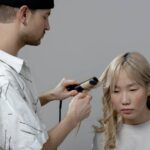Key Takeaways
- Hair straighteners were invented in the late 19th century, and their design and technology have evolved over time.
- The invention of hair straighteners is attributed to various individuals, including Marcel Grateau, Lady Jennifer Bell Schofield, and Isaac K. Shero.
- Hair straightening tools have evolved from heated rods and pressing combs to modern ceramic, tourmaline, and titanium plates.
- Milestones in hair straightening technology include the introduction of adjustable temperature settings, ceramic and tourmaline plates, and wet-to-dry straighteners.
- Hair straighteners have revolutionized hairstyling trends, making straight hair accessible to people with various hair types and inspiring new styling techniques.

Who invented hair straighteners
The first hair straightener was invented by Marcel Grateau, a French hairdresser, in 1872. His invention, known as the Marcel Wave, was a heated rod that created waves in the hair. The Marcel Wave was the predecessor to modern hair straighteners and revolutionized hair styling at the time.
Early hair straightening methods
Before Grateau’s invention, people used a variety of methods to straighten their hair. These methods included using clothing irons, heated metal combs, or simply wrapping wet hair around objects and letting it dry. While these methods were somewhat effective, they were also risky and could cause damage to both the hair and the scalp.
“Marcel Grateau, a French hairdresser, invented the first hair straightener in 1872, paving the way for modern hair straightening tools.”
Table 1: Early Hair Straightening Methods
| Method | Description | Risk Factors |
|---|---|---|
| Clothing irons | Ironing hair between a clothing iron and a towel | Burns, hair damage, uneven results |
| Heated metal combs | Running a heated comb through hair | Scalp burns, hair damage |
| Wrapping wet hair | Wrapping wet hair around objects and letting it dry | Limited effectiveness, potential damage |
Caption: Various methods used for hair straightening before the invention of modern tools.
Evolution of hair straightening tools
From the Marcel Wave in the 19th century, hair straightening tools have evolved significantly, incorporating new technologies and materials to enhance performance and safety. Today’s hair straighteners offer a range of features, such as adjustable temperature settings and ceramic plates, to ensure better hair care and styling.
Electric hair straighteners
In the 20th century, hair straighteners started becoming more advanced with the introduction of electric heating elements. This allowed for more precise temperature control and made it possible for users to achieve better results with less risk of hair damage. The first electric hair straighteners were developed around the 1910s, with some early models resembling today’s flat irons.
“Modern hair straighteners have come a long way since the days of the Marcel Wave, thanks to advancements in technology and materials.”
Ceramic and tourmaline plates
One of the most significant developments in hair straightening tools was the introduction of ceramic and tourmaline plates. Ceramic plates evenly distribute heat, reducing the risk of hot spots that can cause hair damage. Tourmaline plates, a type of crystalline mineral, release negative ions that help to smooth hair and reduce frizz. Both materials offer a smoother glide, minimizing hair snagging and breakage.
Steam straighteners and infrared technology
Recent innovations in hair straightening tools include the use of steam and infrared technology. Steam straighteners utilize water to create steam, which is then used to straighten the hair while minimizing damage. This method is particularly beneficial for individuals with dry or damaged hair. Infrared technology, on the other hand, uses longer wavelengths of light to heat the hair from the inside out, leading to faster styling and reduced damage.
Table 2: Evolution of Hair Straightening Tools
| Era | Invention/Development | Advantages |
|---|---|---|
| 19th century | Marcel Wave | First heated tool for creating waves and straightening hair |
| 20th century | Electric hair straighteners | Precise temperature control, improved safety |
| Late 20th century | Ceramic and tourmaline plates | Even heat distribution, smooth glide, reduced frizz |
| 21st century | Steam straighteners and infrared technology | Minimized damage, faster styling, better results |
Caption: A timeline of the key developments in hair straightening tools throughout history.
Milestones in hair straightening technology
Key milestones in hair straightening technology include the invention of the Marcel Wave, the development of electric straighteners, and the introduction of ceramic and tourmaline plates. These advancements have improved the performance, safety, and hair care benefits of hair straightening tools over time.
Invention of the Marcel Wave
The Marcel Wave, invented by French hairdresser François Marcel in the late 19th century, was one of the first techniques used to straighten hair. This innovation marked the beginning of a new era in hairstyling and laid the foundation for future hair straightening technologies.
Electric hair straighteners
The development of electric hair straighteners in the early 20th century was a major milestone in hair straightening technology. These early electric models featured more precise temperature control, improving both safety and styling results. This invention paved the way for modern hair straighteners that we use today.
“Milestones in hair straightening technology have transformed the way we style our hair, leading to safer and more effective tools.”
Ceramic and tourmaline plates
The introduction of ceramic and tourmaline plates in the late 20th century significantly changed the hair straightening industry. These materials offered even heat distribution, reducing hot spots and the risk of hair damage. The smooth glide and reduced frizz associated with these plates have become staples of modern hair straighteners.
Digital temperature control and auto-shutoff
Recent innovations in hair straightening technology include digital temperature control and auto-shutoff features. Digital temperature control allows users to select the optimal heat setting for their hair type, further reducing the risk of damage. Auto-shutoff features provide added safety by turning off the device after a certain period of inactivity.
Table 3: Milestones in Hair Straightening Technology
| Milestone | Era | Impact |
|---|---|---|
| Invention of the Marcel Wave | 19th century | Foundation for future hair straightening technologies |
| Electric hair straighteners | 20th century | Precise temperature control, improved safety and results |
| Ceramic and tourmaline plates | Late 20th century | Even heat distribution, smooth glide, reduced frizz |
| Digital temperature control and auto-shutoff | 21st century | Enhanced safety and customization, reduced risk of damage |
Caption: Key milestones in the evolution of hair straightening technology and their impact on hairstyling.
The impact of hair straighteners on hairstyling trends
Hair straighteners have revolutionized hairstyling trends by making sleek, smooth, and straight hair accessible to people with different hair types. The invention and improvement of hair straightening tools have also influenced other styling techniques and inspired new trends in the hair care industry.
Widespread adoption of straight hairstyles
The availability of hair straighteners has made it possible for individuals with curly, wavy, or frizzy hair to achieve straight hairstyles. This has led to a widespread adoption of straight hairstyles as a popular and versatile look. Hair straighteners have made it easier for people to change their hairstyles and experiment with different looks.
Emergence of new styling techniques
Hair straighteners are not only used for straightening but also for creating other hairstyles. For example, they can be used to create loose waves, curls, and flips. These versatile tools have expanded the range of hairstyling techniques, allowing people to express their individuality and creativity through their hair.
“Hair straighteners have revolutionized hairstyling trends, making it easier for people to achieve a wide range of looks and styles.”
Focus on hair health and protection
The increasing popularity of hair straighteners has also driven the development of products and treatments designed to protect hair from heat damage. Heat protectant sprays, serums, and deep conditioning treatments have become essential components of many hair care routines. This focus on hair health and protection has led to an increased awareness of the importance of proper hair care and maintenance.
Influence on the professional hair care industry
Hair straighteners have become indispensable tools for hairstylists and salons. The demand for sleek, straight hairstyles has influenced the professional hair care industry to develop advanced straightening treatments, such as keratin treatments and Japanese straightening. These treatments offer longer-lasting results and further expand the range of styling options available to clients.
In conclusion, hair straighteners have had a significant impact on hairstyling trends, contributing to the popularity of straight hairstyles and inspiring new styling techniques. These tools have also led to a greater focus on hair health and protection and influenced the professional hair care industry.
Conclusion
The history of hair straighteners is marked by continuous innovation and improvement. From the earliest heated rods to the advanced tools we have today, hair straighteners have significantly impacted hairstyling trends, techniques, and the professional hair care industry. By understanding the history of these versatile tools, we can better appreciate their role in shaping the way we style and care for our hair today.








